
BROKEN FRONTIER AT 20! So far all articles in our 20th birthday event have been prefaced with an introductory paragraph explaining their importance in BF history or their relevance in representing the site’s ethos. Today’s interview, though, needs no such preamble as I talk with Frederik Hautain, Broken Frontier’s founder, my predecessor in the top spot, and the man who changed my life forever. Let’s jump right in and start reminiscing about BF over the last two decades, share some anecdotes, and perhaps surprise some of you who are newer to the site…
ANDY OLIVER: Let’s begin by casting our minds back to 2002 and the very beginnings of Broken Frontier. What motivated you to create the site two decades ago?
FREDERIK HAUTAIN: Do you want the god honest truth? [Laughs] Well, I fell madly in love with US comics at the age of 7 and ever since securing the required amount of cash to feed my reading appetite was an ongoing struggle: there were so many heroes and universes to explore, their allure in stark contrast with the amounts of pocket money and savings a young teenage boy could amass.
When I was about 15, I quit reading comics for a few years but after entering college, they lured me back in. I knew I couldn’t fall into the same trap of financial worries, so I knew I had to find a way to get my fix without it costing me way more money than I could afford.
During my high school years, I had wooed my schoolmates with fun content as I founded the school newspaper, and even though it didn’t bring me any closer to teenage romance, I discovered I had a knack for publishing content.

BF’s Andy Oliver (left) and Frederik Hautain (right) at Thought Bubble in 2018
With the internet starting to boom and standalone websites becoming more and more of a thing – anyone remember the early days of Geocities and scratchy dial-up modems? – I figured that was my way in. So around the time that I had turned 19, which I then considered to be a ripe age, I learned myself basic HTML and website coding in Microsoft Frontpage and launched Broken Frontier. If I could offer publishers and creators a platform where we’d discuss and promote their books, surely they wouldn’t mind sending me comp copies in return, right? Right. World domination was within my grasp and I didn’t even need an Infinity Gauntlet! The Big Two stayed forever out of reach, but pretty much everyone else fell into my trap. [Laughs]
Come to think of it, it was all a very self-centered undertaking filled with tons of youthful enthusiasm and naiveté.
AO: What was the ethos of the site in those early days? What identity did you look to establish for BF to differ it from other outlets?
HAUTAIN: Back in those days, there weren’t that many websites doing comics coverage. Comic Book Resources and Newsarama were the leaders of the pack, and there were a bunch of second-tier websites like The Beat, Ain’t It Cool News, The Fourth Rail and Silver Bullet. Maybe I’m forgetting some, but hey, I’m twice as old as I was then!
Anyways, CBR and Newsarama and some of the others were in a position to pay contributors… but we weren’t. So, I felt I needed to differentiate by giving readers with strong opinions a platform to share their thoughts on comics. I scoured comic book message boards – even CBR and Newsarama’s – for true comic advocates and invited them to join my modest undertaking. God knows I couldn’t do it alone, and boy, doing updates several times a day in a Frontpage-built website was a long, manual undertaking. My college dorm mates still joke that they never saw me participate in social activities because I was either reading – I studied Literature so I had to devour a lot of novels – or slave laboring away at my computer.
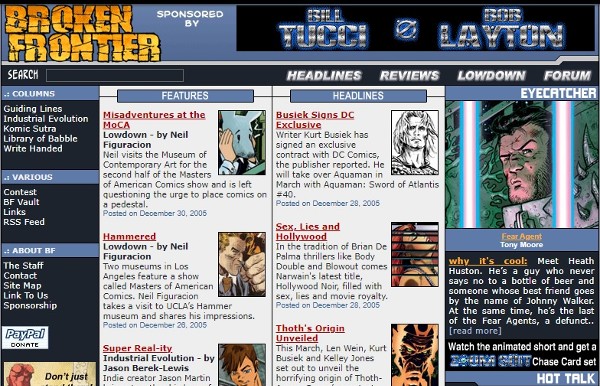
Broken Frontier – the early years!
To my surprise, quite a few of the people I approached said yes and all of a sudden I had a real staff with columnists and reviewers and interviewers.
I wanted to build a place run by fans for fans, which is why the site’s first tagline was ‘Where Fans Come First!’, which ironically was also the first tagline of ReedPOP’s recently launched Popverse, until they changed it a little while back.
Next to our regular contributors, I also gave our readers an opportunity to contribute an article if they had a good idea to further underscore our mission statement. Remember, this was 20 years ago: blogs didn’t exist.
But what really was part of the site’s DNA from the early going was that we gave equal airplay to the smaller publishers as we did to The Big Two. All comics were worthy to be discussed, not just the ones starring superheroes; I remember putting it often as BF ‘walking the tightrope between mainstream and small press & indie’ content. That gave us a good rep with anyone from CrossGen to Dark Horse Image and Oni to publishers that no longer exist today like Slave Labor Graphics, Ape Entertainment, Speakeasy and Viper Comics. Many of them were keen to get attention they couldn’t get elsewhere – it didn’t come as a surprise that we were one of the first to get quoted on the cover of a CrossGen comic when they started pulling quotes from reviews, also a rarity in those days, and that we found out that one CrossGen title was not cancelled in part because of the traction it got through our coverage.
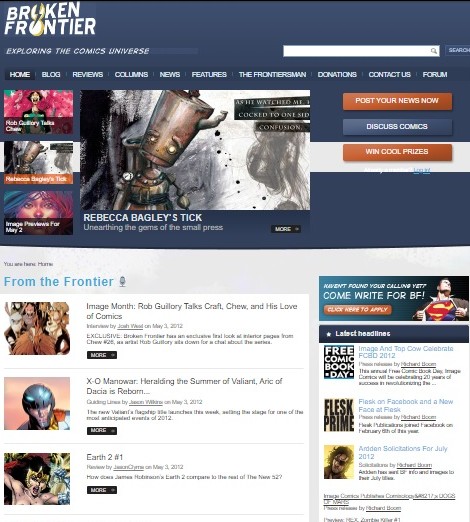
The Broken Frontier of 10 years ago – note the lead UK small press article
Lastly, I decided to use what I feared would be another one of our weaknesses to our advantage: I was an adolescent from across the pond – Belgium of all places – trying to carve out a name for himself and his outlet in an almost all-American industry. And surely there were others out there like me. So pretty soon we had probably the most diverse staff of all back in those days, male and female from the US, Britain, the Netherlands, Belgium, Australia, the Philippines, etc. That was very cool.
AO: What were some of the highlights of that first decade or so of BF for you?
HAUTAIN: I guess I could name a number of things, but really – and I know it sounds terribly corny because it’s what all of them business marketeers say nowadays – it all starts with the people. You can’t build a brand that has zero outside funding or virtually no advertising income if it’s not for the enthusiasm of the people contributing. We were a quite tight group, starting with Chris Hunter, Eric Lindberg, Mike and Angela Bullock almost being in constant contact throughout the day, and the same held true when you joined in 2006 and Bart Croonenborghs joined a year later. I can go on naming others like William Gatevackes, Tonya Crawford, Matthew Clark, Jose Clemente, Fletch Adams, Adrian Zettlemoyer, Sam Moyerman, JP Dorigo, Matt Wilson, Kris Bather, Tyler Chin-Tanner, Jason Berek-Lewis, Jason Wilkins, Tom Murphy, James Wortman, Noel Bartocci, Richard Boom, and so so many more.
And then there are a number of people who BF gave their first big break like journalist Graeme McMillan or at the time up-and-coming creators like Cullen Bunn, Josh Fialkov and A. David Lewis.
It was really because of the efforts of all of these people that we were able to live up to our credo of being a portal for quality comics coverage. If there’s any old staffer reading this: thank you!
The Frontiersman – BF’s digital magazine for the iPad that ran in the early 2010s
Then there were the fun times of us being the little website that could going from a manually updated website to more sophisticated database driven versions allowing us to produce content at a faster rate, the travels to San Diego Comic-Con multiple times (once I was about to enter a panel being stopped by Geoff Johns who recognized me out of the blue, ha, me a 25-year-old kid from Belgium or interviewing Warren Ellis in his hotel room), NYCC, sitting in the Marriott lounge during Wizard World Philadelphia together with John Romita Jr, the late Michael Turner and others and being star struck as hell not knowing what to say, … the brief takeover by Platinum Studios that, even though it ended rather quickly, allowed me to run the website full-time and get a steady salary out of it, our experiment with The Frontiersman, the first digital comics magazine created for tablets when everyone thought the iPad was going to replace print magazines and change reading habits forever. It didn’t pan out, but we gave it our all.
AO: Back in 2013 the site’s direction evolved with a specific remit to focus on the more indie side of comics and to step back from the “mainstream”. Ironically, I remember at the time that I (the small press guy) was less convinced of that shift than you (the more serial comics guy at the time) were! How do you feel that relaunch redefined BF while building on what had gone before?
HAUTAIN: I think the change was necessary since the internet landscape had changed dramatically, with so many other outlets popping up, blogs, tumblr, social media, there was content anywhere, there was clickbait, shortened attention spans, listicles, sites going out of business etc., Hollywood becoming so much more of a driver for comics consumption – or maybe comics IP consumption because there’s a whole new generation of fans out there that love Marvel but haven’t set as much as a toe in a comic book store.
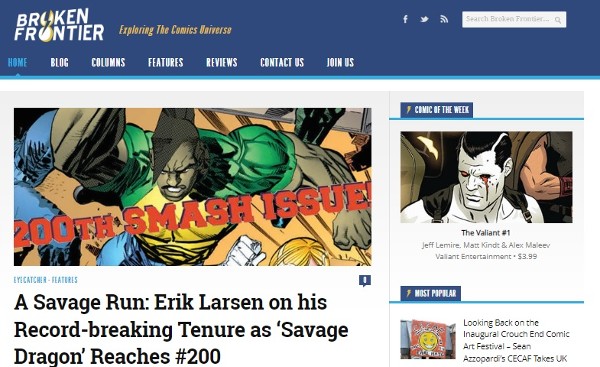
Broken Frontier relaunched in 2013
So, I felt that we needed to further carve out our niche by doing the same quality focus we had become known for – with a smaller but dedicated readership that wasn’t necessarily wooed by star-rated reviews – and zoom in even more on the small press and indie side of things.
AO: I imagine one of the great achievements of Broken Frontier for you would have been the hardback Broken Frontier Anthology of 2016. After one of the most dramatic crowdfunders I can remember, the book reached its target at the last minute. Guide us through the highs and lows of that campaign…
HAUTAIN: Didn’t some people refer to it as the Kickstarter miracle? [Laughs] Oh my, what a stressy time that was! The anthology originated from that very same idea that led us to redouble our efforts towards small press and indie coverage: what could we do to further differentiate ourselves from the pack, do something that no other site was doing. So, Tyler Chin-Tanner, who ran his own publishing company in A Wave Blue World, and I set out on our adventure to put out an anthology that would celebrate creative storytelling in line with the BF DNA: creators from all over the globe coming together to create stories about breaking boundaries and going where no one has gone before.
The spine of the book was going to be the creators who had written a regular column for us over the years: Cullen Bunn, Greg Pak, David Hine, Josh Fialkov, Dave Lewis, and then adding established and new voices on the writing or art side or both. Phil Hester, Jamie Coe, INJ Culbard, Alison Sampson, Marguerite Bennett, Steve Orlando, Box Brown, Noah Van Sciver, PJ Holden, Karrie Fransman, and the like all joined our mammoth oversized hardcover collection (the book is still available via AWBW here – ed.).
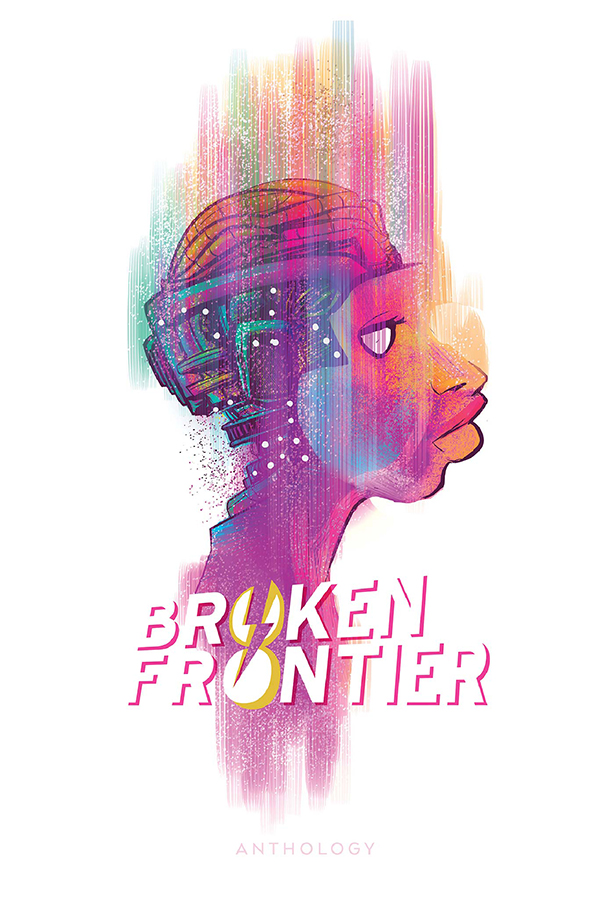
Broken Frontier Anthology cover by Robbi Rodriguez
I studied everything about Kickstarter campaigns that I could and being active in content marketing professionally, what was a good month to launch statistically, when and where should you post about it, etc. I knew about the importance of conversion rates (i.e. the percentage of people actually purchasing a product when seeing an ad or content or another call to action). All together, everyone involved had a total social media following of I think around two million, and even if the conversion rate of our joint number of fans was just a fraction of what marketing literature said it normally was, we’d reach our launch goal in no time. Sure, we needed to reach a fairly high launch goal of $60,000 but that was because of our high production values and our insistence on paying creators industry rates. And hey, we only needed to convince 1500 people out of two million to back the book. What could go wrong? Things would be in the can soon enough.
We got to $4k on day one, $10k by day three… and then everything kind of fell flat. Almost none of the other comics news sites were sharing the news of our campaign (come to think of it, perhaps, why would they support a competitor?) and that extremely modest social media conversion we aimed for didn’t happen either.
Stress set in. We kept pushing. Even to the point that people started complaining they couldn’t go on Facebook or they’d run into a promo piece. A week before the campaign would end we had barely scratched $30k. Why weren’t things working out? We were dead in the water.
Work by EdieOP and Karrie Fransman from the Broken Frontier Anthology
We were doing everything by the book. I was frustrated. Tyler mentioned that maybe it didn’t gain enough traction in part because people didn’t know what they’d be backing specifically. Most of the anthologies being done back then (whose campaigns I had studied closely) didn’t show any preview art either on their campaigns, but when you’re backing a monster or a horror or a romance anthology, you have a pretty good picture of what kind of stories to expect. In marketing terms, looking back, there was a clear target audience, while our book probably did not.
So we approached the creators involved to share visual material about their stories if they could. And that helped. Bit by bit we gained pledges. There was still hope. But two days before the end date, we were still $20k short, a third of our funding goal (go see for yourself on Kicktraq – ed.). I remember some creators telling us this was too big to fail, but that was exactly what was about to happen. Failure. That glimmer of hope I had? Out of the window.
The Broken Frontier Anthology and BF Small Press Yearbook launch at Gosh! Comics in 2016
And then all of a sudden Kickstarter picked the BF Anthology as a project to watch and also mentioned us in their newsletter among noteworthy projects ending soon. A whopping extra $10k in less than 24 hours. And again on the final day of the campaign. With only a few hours left, we were funded. It was unbelievable!
But please, now on to your next question before I have to relive that anxiety even more… [Laughs]
AO: Since stepping back from BF in 2017 you’ve gone on to your own successes as a comics creator. Can you tell us a little about your comics projects in the years after you left Broken Frontier? And also some of your other non-comics creative endeavours!
HAUTAIN: After I had written my first comics script for the anthology, I knew in my heart it was time to start creating stories myself instead of reporting about them.
While running Broken Frontier, I had spent so much time working behind the scenes and coordinating but I never really wrote that many articles or reviews, in part because I lacked the confidence to write. I loved doing interviews – and I still do – because I love talking to people about what they do and what drives them, but actual writing? Oh no, that wasn’t for me.
But then the anthology happened and I told myself that I had to take the opportunity to write a story myself even if it was just a short story that was essentially self-published. Seeing it in print and experiencing the joy of artistic collaboration, I decided in the months after the anthology’s publication that I would stop running BF and focus on creating fiction.
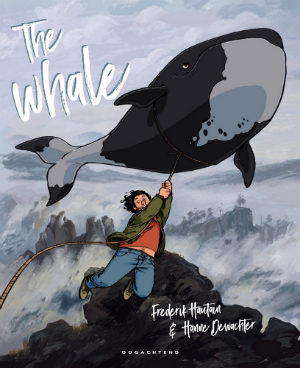 If only I knew of someone capable enough to entrust my baby with and hand over the reins… Ha, just kidding! It was always going to be you, Andy. There was no doubt about it: there wasn’t anyone better positioned to take over the driver’s seat, no one else more perfect to write the next chapter of Broken Frontier’s existence. Again, as I said earlier, it all comes down to people, and you’re one of the best.
If only I knew of someone capable enough to entrust my baby with and hand over the reins… Ha, just kidding! It was always going to be you, Andy. There was no doubt about it: there wasn’t anyone better positioned to take over the driver’s seat, no one else more perfect to write the next chapter of Broken Frontier’s existence. Again, as I said earlier, it all comes down to people, and you’re one of the best.
So, after I left, I started to kick things into higher gear and took out my notebook where I had jotted down several ideas over the years and tried to find artists to collaborate with. Much like I was the little foreign non-native journalist, I wanted to become that foreign non-native writer in US comics. To hell that no continental European had done it before. I would. But finding skilled artists that wanted to work on creator-owned material with an upstart writer proved to be very hard. Again, I was strapped for cash and couldn’t afford to pay an artist, colorist and letterer out of pocket to produce a fully-rendered 8 to 10-page pitch most publishers were looking for.
In the summer of 2017, I voiced my frustration to a Belgian publisher that I had known for years about my struggles to break into the US industry. She said I should try my hand at European-sized material. I replied that I didn’t know the format or the genres well enough – it was US comics that really made me tick. Still, she convinced me to put together a teaser when I had idea and that we would take it from there if it was up to par. A few weeks later, I hit her up with a synopsis, which got an OK if I was able to produce a good script, then awhile later I submitted 30 pages of script and then I was given the go to write the full story of what would become ‘De Walvis’ (The Whale – ed.).
Since then, I decided to start working 80% at the day job to open up more writing time in my schedule – by that time my kids were past the toddler/daycare stage too – and get more creative work done.
I wrote the script for a three-issue fantasy series called ‘Inbreker’ (Burglar – ed.) which will see completion next year and which has a good chance of being picked up in France as well. And then I’ve got three more graphic novels lined up here for the Dutch market for 2023 at various publishers.
If all goes well I should also have my first US comic out somewhere next year – we’ve got four issues approved and if it performs well we can continue the book – and I’m in talks with a creator to do a comedy webcomic on Webtoons. Several of those ideas aimed for the US market that I spoke of I’m still dying to do and so the artist search continues. Same goes for a historical graphic novel that I’ve got greenlit but for which the publisher and I have yet to find the right artistic match.
On the non-comics site, I’ve recently started my own publisher to release a poetry collection (with illustrations by aforementioned fellow BF-alumnus Bart Croonenborghs) and I’ve written a novel that I’m hoping to find a publisher for. And then there’s a short story that’s going to be published here in an anthology right before this upcoming holiday season.
So, step by step, or as I used to say time and again while running BF, onwards and upwards!
AO: We all know the more negative aspects of the comics scene and the challenges that creators face but given that we’re celebrating 20 years of Broken Frontier in this series of interviews we’re asking everyone a variation of this question. Over the last decade or so what were some of the key positive developments within comics as a scene/medium/industry that you think are worth celebrating?
HAUTAIN: I can finally give you a short answer! No doubt about it, the number one development – and I’m going to stick to just this one because it’s the most important one of all in my mind – is creators of all shapes and sizes getting to take ownership of their creativity and established voices finding an audience away from the Big Two. Or taking the audience they built doing superheroes to the independents: so many writers and artists that were doing mainstream work the first half of BF’s existence are hardly doing any Marvel or DC work anymore. While it’s still hard to carve out your place in traditional print comics and for readers or publishers to take a chance on new talent, overall, I feel creator-owned is in a great place.
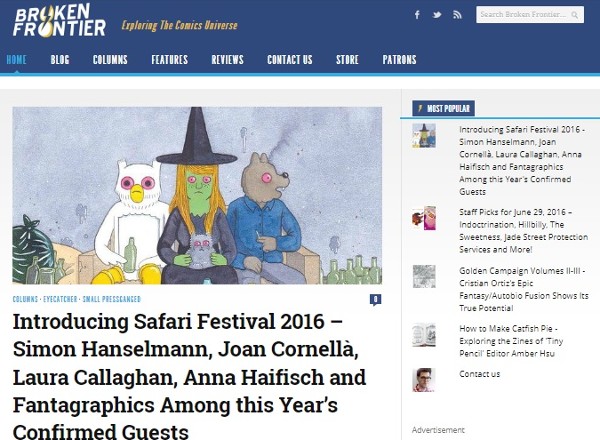
By 2016 BF was firmly entrenched in the indie, alt and small press worlds
AO: Is there an artist/project that you discovered first through Broken Frontier coverage whose work has really inspired you?
HAUTAIN: Inspired, that’s a tough one. I don’t really know who I’m inspired by, really. Not that I want to dodge the question, it’s just something I haven’t really given much thought. In terms of my own artistic career, I look up to people like Neil Gaiman because they’ve successfully bridged comics and literature, and it’s great to see one of my favorite DC publicists from back in the day, Alex Segura, is doing the same thing for example. Speaking of publicity/marketing/PR people, a special thanks and shout out to Filip Sablik, Mel Caylo and Arune Singh who were always a joy to work with, whatever company they were at.
But naming creators, that’s even harder than coming up with Andy Runton, Robert Venditti, Kazu Kibuishi, Brett Weldele, Josh Howard, Jason Howard, Cullen Bunn, Box Brown, the Tamaki sisters, the Luna brothers, Fabio Moon and Gabriel Bá, Gene Luen Yang, Kieron Gillen, Jamie McKelvie, Jim Cheung, Greg Land, Matthew Dow Smith, Michael Cho, Chip Zdarsky, Mark Smylie, David Petersen, Jeff McCommsey, Mark Stafford, Katriona Chapman, Joelle Jones, Farel Dalrymple, Daniel Warren Johnson, Sean Wang, Steve Bryant, Pia Guerra, Niko Henrichon, Robert Sammelin, … the list goes on and on and on and it’s hard not to feel bad about forgetting someone about whom I’m gonna say ‘Of course! Her! Him!’ if I had a list of all the creators we covered or which I interviewed myself laid out in front of me.
In terms of writers specifically, I’ve gotten solid advice from David Hine, Greg Rucka and Kieron Gillen that’s been helpful. You can definitely say they’re an inspiration, so there’s your answer at last. [Laughs] And if I have to name two others whose work has never failed to amaze me over the past twenty years, it’s Ed Brubaker and Brian K. Vaughan.
EdieOP’s video promo for the BF Anthology
AO: Where do you see Broken Frontier in another 20 years? What will the BF of 2042 look like?
HAUTAIN: It’s hard to predict what the future will look like twenty years down the line. I sincerely hope we won’t all be slaves to our screens even more than we are now or locked up in a virtual environment somewhere. If so, the future for humanity as envisioned in The Surrogates or Wall-E comes way too close. [Laughs]
Who knows? We might live in a content landscape where the fast-moving, clickbait stuff is all generated by soulless AI and that our collective attention span goes down even more. But, and this was a nice surprise, I read a report the other week about media consumption among the various age groups and research showed that print media are becoming more popular again among the 15-25 year olds of today. No one in their right mind would’ve placed a bet on that, but I find that very interesting and hopeful, not because I’m slowly turning into a dinosaur who says it was all way better in the past or anything, but I always preferred the quality over quantity and the craftsmanship that’s easier to find in print than online. So again, who knows? It had always been my secret wish from day one back in 2002 to be able to do something in print next to BF’s online endeavours, perhaps there’s an interesting mix waiting around the corner?
Pages from the Broken Frontier Anthology by Noah Van Sciver and Sean Wang
No matter what our content consumption patterns evolve into, there’s always going to be a need for a place that champions small press and indie creators, so I think if BF continues on that path it can only solidify its position as a respected source for quality comics coverage that offers something uniquely different than everybody else, with a true connection with its readers and the creative community it aims to support. It’s an approach that won’t lead to world domination, but it’s one from the heart and one that makes a difference. Isn’t that what it should be about?
Interview by Andy Oliver
Top BF logo by Joe Stone





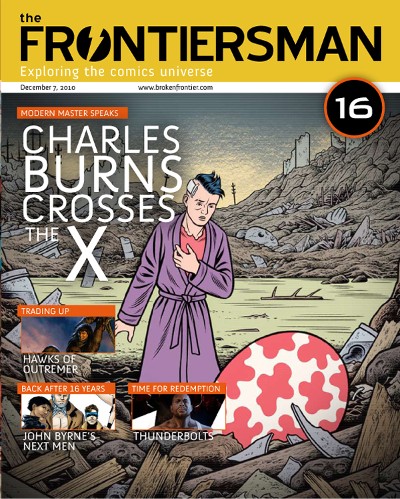
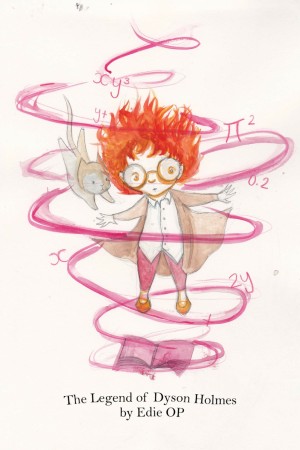
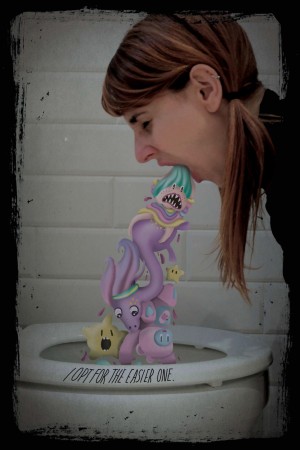
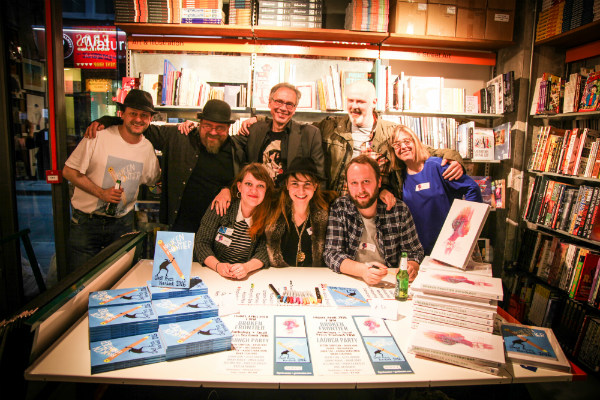
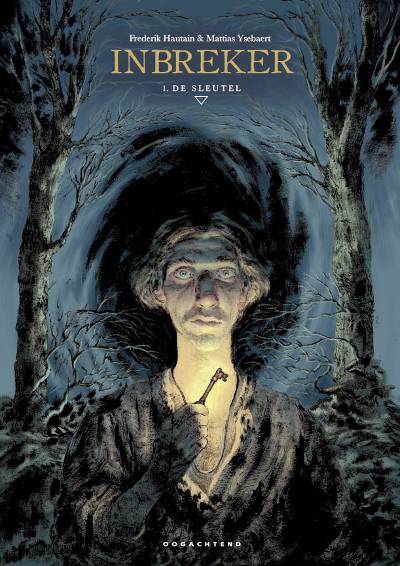
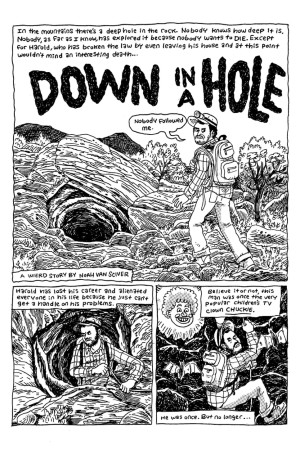
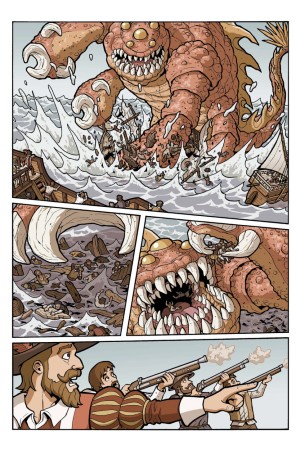
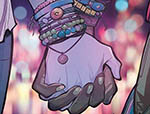
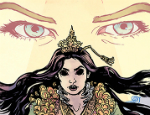
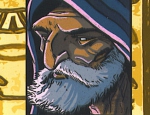
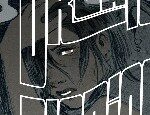
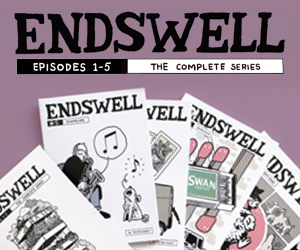




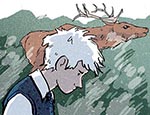
That was such a great read! Writing for Broken Frontier was such a joy and taught me so much! Thank you Frederik and Andy, and happy birthday! It’s awesome to hear that you’re creating more comics too Frederik! 😛